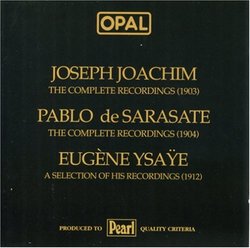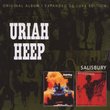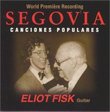| All Artists: Johann Sebastian Bach, Joseph Joachim, Johannes Brahms, Pablo de Sarasate, Frederic Chopin, Emmanuel Chabrier, Gabriel Faure, Felix [1] Mendelssohn, Henryk Wieniawski, Camille de Creus Title: Joachim, Sarasate, Ysa�e Members Wishing: 0 Total Copies: 0 Label: Pearl Release Date: 1/21/1993 Genres: Dance & Electronic, International Music, Special Interest, Classical Styles: Chamber Music, Forms & Genres, Concertos, Historical Periods, Baroque (c.1600-1750), Modern, 20th, & 21st Century, Instruments, Strings Number of Discs: 1 SwapaCD Credits: 1 UPCs: 727031985129, 027031985120 |
Search - Johann Sebastian Bach, Joseph Joachim, Johannes Brahms :: Joachim, Sarasate, Ysa�e
 | Johann Sebastian Bach, Joseph Joachim, Johannes Brahms Joachim, Sarasate, Ysa�e Genres: Dance & Electronic, International Music, Special Interest, Classical
|
Larger Image |
CD DetailsSimilar CDs |
CD ReviewsWonderful aural journey 06/08/2001 (4 out of 5 stars) "A difficult, but highly musically rewarding album. Acoustic lateral-cut recordings made before about 1907-08 are extremely difficult to listen to unless the auditor adjusts to the distinctive colors, limitations, and mechanical interferences (notably surface noise) of the process. It is also helpful to realize that the violin was one of the most problematic instruments to record by the acoustic process, due to the violin's largely non-directional method of sound emission; instruments with a pointable sound aperture (most wind instruments, for example) recorded better becuse you could direct the sound straight into the recording horn. Assuming these conceptual hurdles are cleared, we have a document of three distinctive nineteenth-century musicians playing in styles so divergent from "modern" practice as to require twenty-first century auditors to develop completely different standards of assessment in order to appreciate what they hear. Truly, these recordings are a sonic glimpse into another world. The most problematic, both for current listeners and for his own contemporaries, is Joachim. He is also the oldest violinist of the three at the time of his recordings (72), and critics had had questions about certain elements of his playing style for many years before--most notably, his intonation, which was odd enough to provoke a spirited defense of it by George Bernard Shaw, a man who rarely defended ANY musician he reviewed. Also, his almost complete lack of vibrato is decidedly unsettling unless you realize that vibrato was regarded as an expressive device rather than a necessity until 1900, and Joachim had been concertizing since the 1840s. One of Joachim's students, Howard Rattay, was concertmaster of the Victor Orchestra attached to the Victor Talking Machine Company, and Rattay's similarly vibratoless style can be heard supporting dozens of Caruso, McCormack, Farrar, and other Red Seal artists' performances into the late 1910s. Joachim's bow is also not the steadiest all the time; but what is astonishing is the broad style and committment to the brief extracts the Gramophone Company allowed him to record. The Bach extracts are fascinating in many ways, not only because of Joachim's distinctive (and surprisingly sober) performance, but also because they were about the only Bach pieces available on record ANYWHERE in 1903! Think about that the next time you see a store with umpteen record bins filled with more Bach than even God wants to hear! Sarasate's E major Preludio is the other Bach that came on the market in 1904, and it is the weirdest rendition on record--played so fast and uncomfortably it sounds like a cockeyed etude! (I also happen to like it very much--it brings Bach off his irritatingly exalted pedestal into the realm of humanity.) Other than that, Sarasate's style is much more accessible than Joachim's, with a constant vibrato and a flexibility of approach that verges on erratic. (Rubato WAS king.) Sarasate's intonation is occasionally imprecise, but the man had enormous style; the cadenzas in the first part of Zigeunerweisen are gossamer-like. The rest of his pieces are a mixed bag as far as musical "value", but all are at least fun and very idiomatic.I wish I could recommend the Ysaye transfers more highly, but the Sony collection of his complete solo recordings (plus several of his sides as conductor of the Cincinnati Symphony in the late Teens) beats these transfers hollow. However, Ysaye's musicianship and grace comes through even here, and this is a good "starter" set in that regard. His Mendelssohn concerto finale is lovely and dancelike, but he must have made the Columbia recording engineers very nervous--it fills a 12" 78 side as full as possible and then some, running a full minute over the usual 4-minute limit, even with two cuts. (You can hear Ysaye flub the second cut and then recover himself magnificently.)If you are looking for pristine, squeaky clean performances with current ideas of bowing, intonation, and interpretation, buy a recently-released disc of a modern violin superstar. If you want to enter another aural world and are willing to listen historically to performers who were regarded as highly idiosyncratic even in their own day, this is a wonderful CD. It does take work, but it's well worth it." The Most Important Record Ever Made? orpington | Nebraska | 10/22/2001 (5 out of 5 stars) "They key to appreciating the importance of this recording is to not try to listen to it through 21st century ears but through 19th century ears. This performance is remarkable in how it gives a key to the past AND guidance for the future of classical music. Really.See Peter Gutmann's most-excellent review of Joachim's performance of Brahm's Hungarian Dance #2(...)" The most important recording ever!! hollas | 11/16/2003 (5 out of 5 stars) "This is the most important recording ever! It is true that they are not perfect but even today with all the millions of cuts there are 2 or 3 notes on every recording that aren't good. Joachim plays Bach with a wisdom that is far beyond almost anybody playing today. Sarasate is now probably my favourite violinist. He has a style, grace, and elegance that is so personal that it captures the very essence of the 19th century. I say throw away your perfect intonation, your big sound, your wide vibrato. The most interesting thing about this style is the way that they don't "romanticize" the phrases nearly as much as today, giving the pieces a better overall conception. You don't remember something really special but rather the general impression. I have heard many violinists speak fondly of "the old guys" but never does it translate into the actual playing. Put on your 19th century ears. Let's throw out perfection for a more raw personal way of music making."
|

 Track Listings (19) - Disc #1
Track Listings (19) - Disc #1
